 W
WRicardo Almendáriz was a Guatemalan draftsman who accompanied Antonio del Río to the first excavation of pre-Columbian Maya ruins at Palenque in Chiapas, Mexico. Undertaken in May and June 1787, the expedition was performed under orders from Charles III of Spain to investigate reports about the ruins from the inhabitants of the neighboring pueblo of Santo Domingo de Palenque. The team spent two weeks digging at the location followed by three weeks studying the site.
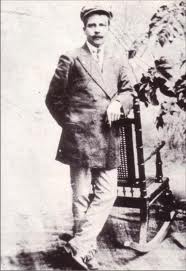 W
WUrteaga Alvarado, Mario was a Peruvian painter. He originally worked as a painter, photographer and upon his return to Cajamarca from Lima he works as a school teacher, farming and journalist.
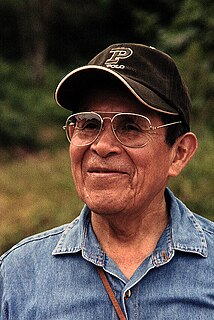 W
WPablo Cesar Amaringo Shuña was a Peruvian artist, renowned for his intricate, colourful depictions of his visions from drinking the entheogenic plant brew ayahuasca. He was first brought to the West's attention by Dennis McKenna and Luis Eduardo Luna, who met Pablo in Pucallpa while traveling during work on an ethnobotanical project. Pablo worked as a vegetalista, a shaman in the mestizo tradition of healing, for many years; up to his death, he painted, helped run the Usko-Ayar school of painting, and supervised ayahuasca retreats.
 W
WJacobo Angeles is a Mexican artisan from San Martín Tilcajete, Oaxaca who is known for his hand carved and distinctly painted alebrije figures. The town is noted for its production of these figures which generally are carvings of animals painted in bright colors and bold designs, and Angeles grew up carving the local wood they are made from. The artisan’s work has become distinguished for the painting of fine, intricate designs over the base paint, often inspired by Zapotec and other indigenous designs. He works with his wife María del Carmen Mendoza, at the couple’s home and workshop in their hometown. While Angeles continues to create alebrijes, much of the production of the workshop is done by younger members of the Angeles family, which is a tourist attraction in the town. Angeles travels frequently to promote alebrijes and Zapotec culture, especially in the United States, and his work has been shown in major venues in Mexico and abroad, as well as featured in two books. In 2014, he was invited to the Vatican to meet Pope Francis and set alebrije nativity scenes and Christmas tree ornaments.
 W
WMiguel Mateo Maldonado y Cabrera (1695–1768) was a Mestizo painter born in Oaxaca but moved to Mexico City, the capital of Viceroyalty of New Spain. During his lifetime, he was recognized as the greatest painter in all of New Spain. He created religious and secular art for the Catholic Church and wealthy patrons. His casta paintings, depicting interracial marriage among Amerindians, Spaniards and Africans, are considered among the genre's finest. Cabrera's paintings range from tiny works on copper to enormous canvases and wall paintings. He also designed altarpieces and funerary monuments.
 W
WMartín Chambi Jiménez, was a photographer, originally from southern Peru. He was one of the first major indigenous Latin American photographers.
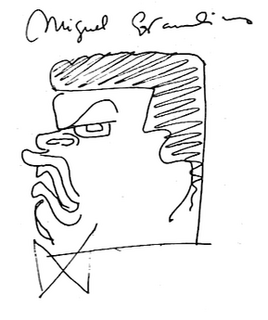 W
WMiguel Covarrubias, also known as José Miguel Covarrubias Duclaud was a Mexican painter, caricaturist, illustrator, ethnologist and art historian. Along with his American colleague Matthew W. Stirling, he was the co-discoverer of the Olmec civilization.
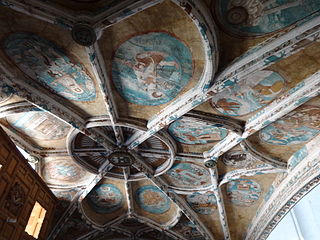 W
WJuan Gerson was a high status indigenous Nahua painter, named after the French theologian Jean Gerson, working in Tecamechalco, Puebla. Not until 1962 when a group of Mexican scholars found documentation to his high status indigenous heritage was Gerson identity revealed. It was previously thought he was Flemish, trained in Italy, working from entirely within the European tradition before coming to colonial Mexico. Art historians Carolyn Dean and Dana Leibsohn consider Gerson's case of misrecognition as "reveal[ing] once again our refusal to recognize the indigene unless his or her work is visibly pre-Hispanic. Further, the revisions of scholarship that follow the discovery of these artists' genetic make-up involve a literal re-seeing of their work." Mexican art historian Francisco Pérez Salazar considers his work "mediocre and defective."
 W
WLuis González Palma (1957) is a Guatemalan photographer. Much of his work "has revolved around the strange hybrids of race and culture that add up to Latin America."
 W
WFelipe Guaman Poma de Ayala, also known as Huamán Poma or Wamán Poma, was a Quechua nobleman known for chronicling and denouncing the ill treatment of the natives of the Andes by the Spanish after their conquest. Today, Guamán Poma is noted for his illustrated chronicle, Nueva corónica y buen gobierno.
 W
WOswaldo Guayasamín was an Ecuadorian painter and sculptor of Kichwa and Mestizo heritage.
 W
WLuis Rolando Ixquiac Xicará is an indigenous artist born in Quetzaltenango, Guatemala. He studied at the Escuela Nacional de Artes Plásticas "Rafael Rodríguez Padilla" in Guatemala, and continued his studies in Paris, France.
 W
WMagdalena Carmen Frida Kahlo y Calderón was a Mexican painter known for her many portraits, self-portraits, and works inspired by the nature and artifacts of Mexico. Inspired by the country's popular culture, she employed a naïve folk art style to explore questions of identity, postcolonialism, gender, class, and race in Mexican society. Her paintings often had strong autobiographical elements and mixed realism with fantasy. In addition to belonging to the post-revolutionary Mexicayotl movement, which sought to define a Mexican identity, Kahlo has been described as a surrealist or magical realist. She is known for painting about her experience of chronic pain.
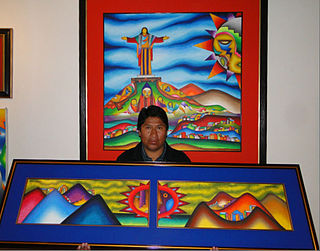 W
WMamani Mamani is an Aymara artist from Bolivia. His work is significant in its use of Aymara indigenous tradition and symbols. His art has been exhibited around the world, including shows in Washington, D.C., Tokyo, Munich, China, Singapore, and London.
 W
WArnulfo Mendoza Ruiz was an artist and weaver, who exhibited his work both in Mexico and abroad. Born in Teotitlán del Valle, Oaxaca, a well-known center for traditional Zapotec weaving, he became one of its best-known artisans, recognized as a “grandmaster” by the Fundación Cultural Bancomer. As director of La Mano Mágica gallery and with his former wife Mary Jane Gagnier, he also worked to promote Oaxacan folk art and handicrafts.
 W
WCarlos Mérida was a Guatemalan artist who was one of the first to fuse European modern painting to Latin American themes, especially those related to Guatemala and Mexico. He was part of the Mexican muralism movement in subject matter but less so in style, favoring a non-figurative and later geometric style rather than a figurative, narrative style. Mérida is best known for canvas and mural work, the latter including elements such as glass and ceramic mosaic on major constructions in the 1950s and 1960s. One of his major works, 4000m2 on the Benito Juarez housing complex, was completely destroyed with the 1985 Mexico City earthquake, but a monument to it exists at another complex in the south of the city.
 W
WRodolfo Morales was a Mexican painter, who incorporated elements of magic realism into his work.
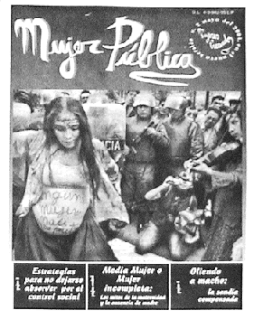 W
WMujeres Creando is a Bolivian anarcha-feminist collective that participates in a range of anti-poverty work, including propaganda, street theater and direct action. The group was founded by María Galindo, Mónica Mendoza and Julieta Paredes in 1992 and members including two of Bolivia's only openly lesbian activists.
 W
WDiego Quispe Tito (1611–1681) was a Quechua painter from Peru. He is considered the leader of the Cuzco School of painting.
 W
WDiego María de la Concepción Juan Nepomuceno Estanislao de la Rivera y Barrientos Acosta y Rodríguez, known as Diego Rivera, was a prominent Mexican painter. His large frescoes helped establish the mural movement in Mexican and international art.
 W
WBasilio Pacheco de Santa Cruz Pumacallao (1635–1710) or Basilio de Santa Cruz Puma Callao was a Peruvian painter of Quechua (Inca) and Ladino origin from Cusco, Peru. He was part of the Cuzco School, a colonial movement of indigenous painters educated in the Baroque religious painting tradition of Spain.
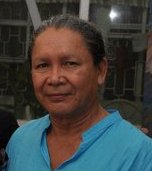 W
WGeorge Simon was a Guyanese Lokono Arawak artist and archaeologist. He was the founder and mentor of the Lokono Artists Group, a group of Lokono artists from Guyana, based primarily in Simon's hometown of St. Cuthbert's Mission. Simon was widely regarded as one of the leading Guyanese artists of his generation, and his paintings are notable for their explorations of Amerindian culture and the Guyanese environment. He was also recognized for his achievements as an educator, his efforts to develop opportunities for Amerindian artists in Guyana, and for his work as an archaeologist.
 W
WRufino del Carmen Arellanes Tamayo was a Mexican painter of Zapotec heritage, born in Oaxaca de Juárez, Mexico. Tamayo was active in the mid-20th century in Mexico and New York, painting figurative abstraction with surrealist influences.
 W
WFrancisco Benjamín López Toledo, known as Francisco Toledo, was a Mexican Zapotec painter, sculptor, and graphic artist. In a career that spanned seven decades, Toledo produced thousands of works of art and became widely regarded as one of Mexico's most important contemporary artists. An activist as well as an artist, he promoted the artistic culture and heritage of his home state of Oaxaca. Toledo was considered part of the Breakaway Generation of Mexican art.
 W
WMirta Toledo is an Argentine artist, that promotes diversity through her artwork.
 W
WJoaquin Alberto Vargas y Chávez was a noted Peruvian painter of pin-up girls. He is often considered one of the most famous of the pin-up artists. Numerous Vargas paintings have sold and continue to sell for hundreds of thousands of dollars.
 W
WMarcos Zapata, also called Marcos Sapaca Inca, was a Peruvian painter, born in Cuzco. He was one of the last members of the Cuzco School, an art center in which Spanish painters taught native students to paint religious works. Zapata introduced elements from his own lands into his paintings. For instance, his 1753 rendering of the Last Supper shows Jesus and his disciples gathering around a table laid with guinea pig and glasses of chicha.